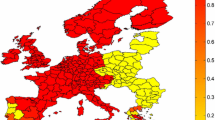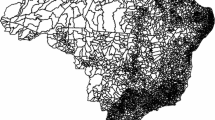Abstract
Discrete Markov chain models (DMCs) have been widely applied to the study of regional income distribution dynamics and convergence. This popularity reflects the rich body of DMC theory on the one hand and the ability of this framework to provide insights on the internal and external properties of regional income distribution dynamics on the other. In this paper we examine the properties of tests for spatial effects in DMC models of regional distribution dynamics. We do so through a series of Monte Carlo simulations designed to examine the size, power and robustness of tests for spatial heterogeneity and spatial dependence in transitional dynamics. This requires that we specify a data generating process for not only the null, but also alternatives when spatial heterogeneity or spatial dependence is present in the transitional dynamics. We are not aware of any work which has examined these types of data generating processes in the spatial distribution dynamics literature. Results indicate that tests for spatial heterogeneity and spatial dependence display good power for the presence of spatial effects. However, tests for spatial heterogeneity are not robust to the presence of strong spatial dependence, while tests for spatial dependence are sensitive to the spatial configuration of heterogeneity. When the spatial configuration can be considered random, dependence tests are robust to the dynamic spatial heterogeneity, but not so to the process mean heterogeneity when the difference in process means is large relative to the variance of the time series.






Similar content being viewed by others
Notes
We thank an anonymous referee for suggesting this possibility.
Since all the results suggest that they have very similar properties, we will only present and discuss results concerning \(\chi ^2\) tests. Full results are available from the authors.
In this paper we always adopt the same discretization strategy on the spatial lags as that on regional time series.
References
Aghion P, Howitt P (1997) Endogenous growth theory. MIT Press, Cambridge
Anselin L (1990) Some robust approaches to testing and estimation in spatial econometrics. Reg Sci Urban Econ 20(2):141–163
Anselin L, Rey S (1991) Properties of tests for spatial dependence in linear regression models. Geograph Anal 23(2):112–131
Barro RJ, Sala-i Martin X (1991) Convergence across states and regions. Brook Pap Econ Act 1:107–182
Bickenbach F, Bode E (2003) Evaluating the Markov property in studies of economic convergence. Int Reg Sci Rev 26(3):363–392
Bosker M, Krugell W (2008) Regional income evolution in South Africa after apartheid. J Reg Sci 48(3):493–523
Fingleton B (1997) Specification and testing of Markov chain models: an application to convergence in the European Union. Oxf Bull Econ Stat 59(3):385–403
Floden M (2008) A note on the accuracy of Markov-chain approximations to highly persistent AR (1) processes. Econ Lett 99(3):516–520
Galindev R, Lkhagvasuren D (2010) Discretization of highly persistent correlated AR(1) shocks. J Econ Dyn Control 34(7):1260–1276
Hammond GW (2004) Metropolitan/non-metropolitan divergence: a spatial Markov chain approach. Papers Reg Sci 83(3):543–563
Jones CI (1997) On the evolution of the world income distribution. J Econ Perspect 11(3):19–36
Kopecky KA, Suen RM (2010) Finite state Markov-chain approximations to highly persistent processes. Rev Econ Dyn 13(3):701–714
Kullback S, Kupperman M, Ku HH (1962) Tests for contingency tables and Markov chains. Technometrics 4(4):573–608
Le Gallo J (2004) Space-time analysis of GDP disparities among European regions: a Markov chains approach. Int Reg Sci Rev 27(2):138–163
Le Gallo J, Chasco C (2008) Spatial analysis of urban growth in Spain, 1900–2001. Empir Econ 34(1):59–80
LeSage JP, Cashell BA (2015) A comparison of vector autoregressive forecasting performance: spatial versus non-spatial Bayesian priors. Ann Reg Sci 54(2):533–560
Liao FH, Wei YD (2012) Dynamics, space, and regional inequality in provincial China: a case study of Guangdong province. Appl Geogr 35(1–2):71–83
López-Bazo E, Vayá E, Mora AJ, Suriñach J (1999) Regional economic dynamics and convergence in the European Union. Ann Reg Sci 33(3):343–370
Lütkepohl H (2005) New introduction to multiple time series analysis. Springer, Berlin
Monasterio LM (2010) Brazilian spatial dynamics in the long term (1872–2000): “path dependency” or “reversal of fortune”? J Geogr Syst 12(1):51–67
Quah D (1993a) Empirical cross-section dynamics in economic growth. Eur Econ Rev 37(2):426–434
Quah D (1993b) Galton’s fallacy and tests of the convergence hypothesis. Scand J Econ 95(4):427–443
Quah DT (1996) Empirics for economic growth and convergence. Eur Econ Rev 40(6):1353–1375
Rey SJ (2001) Spatial empirics for economic growth and convergence. Geograph Anal 33(3):195–214
Rey SJ (2015) Discrete regional distribution dynamics revisited. J Reg Urban Econ 1/2:83–103
Rey SJ, Gutiérrez MLS (2015) Comparative spatial inequality dynamics: the case of Mexico and the United States. Appl Geogr 61(July):70–80
Rey SJ, Le Gallo J (2009) Spatial analysis of economic convergence. In: Mills TC, Patterson K (eds) Palgrave handbook of econometrics, vol 2., Applied econometrics Palgrave Macmillan UK, London, pp 1251–1290
Schettini D, Azzoni CR, Paez A (2011) Neighborhood and efficiency in manufacturing in Brazilian regions: a spatial Markov chain analysis. Int Reg Sci Rev 34(4):397–418
Tauchen G (1986) Finite state Markov-chain approximations to univariate and vector autoregressions. Econ Lett 20(2):177–181
Tauchen G, Hussey R (1991) Quadrature-based methods for obtaining approximate solutions to nonlinear asset pricing models. Econometrica 59(2):371–396
Terry SJ, Knotek ES (2011) Markov-chain approximations of vector autoregressions: application of general multivariate-normal integration techniques. Econ Lett 110(1):4–6
Wolf LJ, Rey SJ (2015) On the lumpability of regional income convergence. Letters in spatial and resource sciences, pp 1–11
Acknowledgments
This research was supported in part by National Science Foundation Grant SES-1421935.
Author information
Authors and Affiliations
Corresponding author
Appendix: Contemporaneous cross-correlation in a VAR with temporally lagged spatial spillovers
Appendix: Contemporaneous cross-correlation in a VAR with temporally lagged spatial spillovers
Given a stable first-order VAR of dimension n:
with:
and:
with \({\hat{\alpha }}\) and \(\hat{\rho }\) diagonal matrices of order n, the variance–covariance matrix at lag h, \(\Gamma (h)\) can be derived by following the approach in Lütkepohl (2005) by first re-expressing the VAR in mean adjusted form:
where \(\mu = E[Y_t] = (I - A)^{-1}\nu \), post-multiplying by \((y_{t-h}-\mu )'\) and taking expectations:
The contemporaneous variance–covariance matrix is obtained when \(h=0\):
and by the Yule–Walker equations, when \(h>0\):
For \(h=1\), Eq. (23) becomes:
and substituting for \(\Gamma (1)\) in Eq. (22) gives:
Using the vec operator this can be expressed as:
As an example, consider the \(n=3\) VAR(1) system. Setting \(\alpha _1=\alpha _2=\alpha _3=0.5\), \(\rho _1=\rho _2=\rho _3=0.4\) and noting the spatial relations are such that regions 1 and 2 are neighbors, as are regions 2 and 3. With a simple row-standardized weights matrix we have:
Further assume the innovations are independent over time and space so that \(\Sigma _{\epsilon } = 0.5I_{n}\), and using Eq. (25), the contemporaneous variance–covariance matrix for \(Y_t\) is:
By contrast, if \(\rho =0.0\) and all other parameters are the same, the variance–covariance matrix takes a very different form:
Not only are the regional covariances all zero, but the process variances (\(V(Y_t)\)) become spatially homoscedastic. In contrast, when there are spillovers, the contemporaneous covariances (Eq. 28) between all pairs are nonzero and the process variances are spatially heteroscedastic even though the original innovations were spatially homoscedastic.
Rights and permissions
About this article
Cite this article
Rey, S.J., Kang, W. & Wolf, L. The properties of tests for spatial effects in discrete Markov chain models of regional income distribution dynamics. J Geogr Syst 18, 377–398 (2016). https://doi.org/10.1007/s10109-016-0234-x
Received:
Accepted:
Published:
Issue Date:
DOI: https://doi.org/10.1007/s10109-016-0234-x




